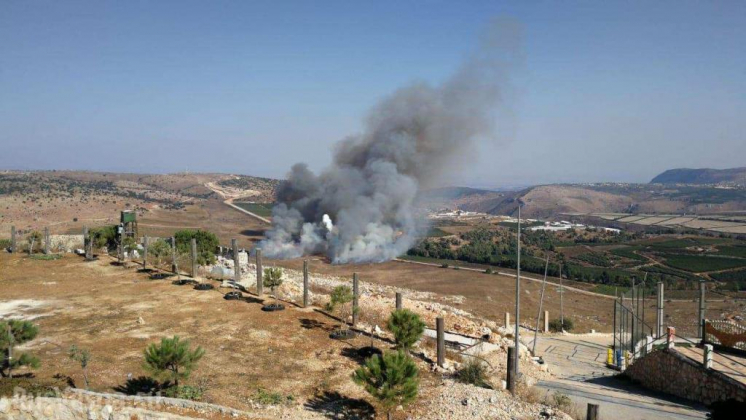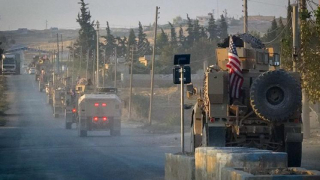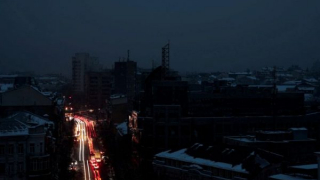Hezbollah and Israel, anatomy of a conflict
05.09.2019
The recent skirmishes between the soldiers of the Party of God and the Israeli armed forces have brought the specter of the 2006 war back to the world. It is the ideal opportunity to return to the origins of this conflict over a decade and understand the interests at stake.
An afternoon of September 1, Lebanon-Israel border, a Hezbollah battalion attacks an Israeli tank with anti-tank missiles. The Tel Aviv reaction is immediate and the border between the two countries turns into hell for a few hours. Some initial reports speak of deaths and injuries among the Israelis, but later they are denied by them. The big media are rushing to spread Benjamin Netanyahu's version as one: it was a premeditated and unprovoked attack by the Lebanese organization, the Israeli armed forces would simply respond in proportion.
What, however, is given less prominence is that in the days before the skirmish, Israel had sent a military drone to southern Lebanon for environmental monitoring missions, that is, to map the territory in anticipation of future military operations. The drone in question had been shot down by Hezbollah, while the Lebanese government had denounced the violation of its airspace as a highly hostile act.
The Israeli response was not long in coming: in the two days before the beginning of September, men, armored vehicles and launch stations had been piled up along the northern border. They were just waiting for an order, but Hezbollah anticipated them, using the same preventive defense doctrine popularized by the Bush Jr. administration and widely used by Israel since its foundation.
In the expectation of further developments, it is important to understand the role played by Hezbollah in the subsidiary war between the main powers of the Middle East: Israel and Iran.
Hezbollah literally means “Party of God”, it is a political organization, endowed with a military wing, born in the 1980s with the aim of fighting against the Israeli occupation of southern Lebanon. The small country was, in fact, the subject of two Israeli invasions, in 1978 and 1982, with the aim of creating a buffer zone and extending an informal domain in the country, in which acted several acronyms of the Palestinian guerrillas.
The Party of God was born on the inspiration of the conservative Iranian revolution of 1979 and, precisely because of this ideological reference, since the beginning it has been considered an instrument of Tehran by the United States and Israel, from which it is considered a terrorist organization like Al Qaeda.
It is undoubtedly true that the rise of Hezbollah has meant for Lebanon the fall in a climate of perpetual instability, because it is cursed by geography to be bordering on Israel, whose chronic insecurity linked to an encirclement syndrome of Prussian memory is linked to events that preceded and accompanied the birth [of Israel].
Beirut's attempts to reach a compromise and maintain its sovereignty have always clashed with the Israeli double game: in July 1993, while the executives of the two countries were talking about the cessation of hostilities, the armed forces launched a massive attack, which lasted one week, with the aim of neutralizing Hezbollah. They failed, but tried again three years later with the operation Bunches of Anger. The Israeli military operation entered the annals of history due to the violence used, contributing to a significant crackdown in relations with the pro-Zionist Maronites: aviation concentrated attacks on Qana, hitting civilians and targets unrelated to Hezbollah and even Beirut was not spared.
More than 35 thousand bombs were dropped in two weeks of campaigning, but the most shocking event was the bombing of a United Nations base in Qana, which Israel believed was a refuge for Hezbollah's soldiers but which had actually been equipped as a refuge for the displaced by bombing: 106 people, all civilians, died, including some members of the international organization.
The campaign turned out to be a failure: of the more than 150 deaths overall, less than 20 were members of Hezbollah. From this moment in history, the popularity of the army-party in the eyes of the Lebanese has grown steadily and uninterruptedly, ceasing to be a reason for the division between Maronite and Islamic Christians but becoming a peculiar element of the contemporary Lebanese identity.
But the most famous event of the clash between Hezbollah and Israel, which is also considered the first episode of the thickness of the subsidiary war between Tehran and Tel Aviv, is certainly the summer 2006 war. The mutual skirmishes between the two actors resulted in a large-scale conflict, which Israel fought by air, land and sea operations (a naval blockade), and which Hezbollah fought using asymmetric warfare tactics.
Also in this case, Israel attacked civilian targets, including Beirut international airport, with the aim of demoralizing the population and isolating the country, in which aid came directly from Iran.
Hezbollah's reaction was unexpected in quality and quantity: an average of 100 missiles per day were launched in the Israeli direction, entire military bases were destroyed by rocket attacks and successful ambushes carried out almost daily, and 52 tanks were severely damaged , of which 4 completely destroyed. Haaretz, one of Israel's most famous newspapers, described the Party of God as “well organized, trained, capable and highly motivated”.
Finally, the two parties reached a ceasefire agreement, which continues to this day. But the consolidation of Hezbollah, also and above all as a political entity and the gradual realization of the Iranian foreign agenda aiming at the construction of a Shiite axis from Tehran to Beirut, passing through Baghdad and Damascus, have led Israel and the United States to resume warmongering.
In recent months, several countries have declared Hezbollah as a terrorist organization, including Argentina and Paraguay, while Israeli surgical operations in Syria and Iraq have increased with the aim of destroying arsenals and bases thought close to Hezbollah.
Writing about Hezbollah is not only sensitive, but also complicated. What on one side of the world is considered to all intents and purposes an entity of religious and political terror, in Lebanon is recognized by the majority of the population as a legitimate party force. This is demonstrated by the results of the general elections last year, in which the Hezbollah bloc obtained almost 17% of the vote - the first coalition by number of votes.
But Hezbollah is not only Lebanon, because it also operates in Latin America in collusion with the existing anti-American governments, is very significantly linked to the Italy of the First Republic and was helped in the course of its existence even by countries apparently aligned with Israel, like Russia.
***************************
Original article by Emanuel Pietrobon:
Translation by Costantino Ceoldo – Pravda freelance












